Report: Managing Personal and Professional Development - NHS Staff
VerifiedAdded on 2020/07/22
|11
|3014
|204
Report
AI Summary
This report provides a comprehensive analysis of personal and professional development within the National Health Service (NHS). It begins by identifying sources of information on professional development trends and evaluating their validity, followed by an exploration of how these trends influence the need for professional development within the workplace. The report then assesses the author's current and future personal and professional development needs, outlining the benefits of such development for both the individual and the organization. It explains the basis for selecting development actions, using skills gap analysis to identify future needs and creating a personal and professional plan. The report also discusses the importance of setting SMART objectives and evaluating progress toward personal and professional development goals, including feedback received from others. The analysis covers training opportunities, appraisal objectives, and how to take advantage of professional networks and bodies to enhance personal and professional growth within the healthcare setting.

MANAGE PERSONAL AND
PROF DEVELOPMENT
PROF DEVELOPMENT
Paraphrase This Document
Need a fresh take? Get an instant paraphrase of this document with our AI Paraphraser
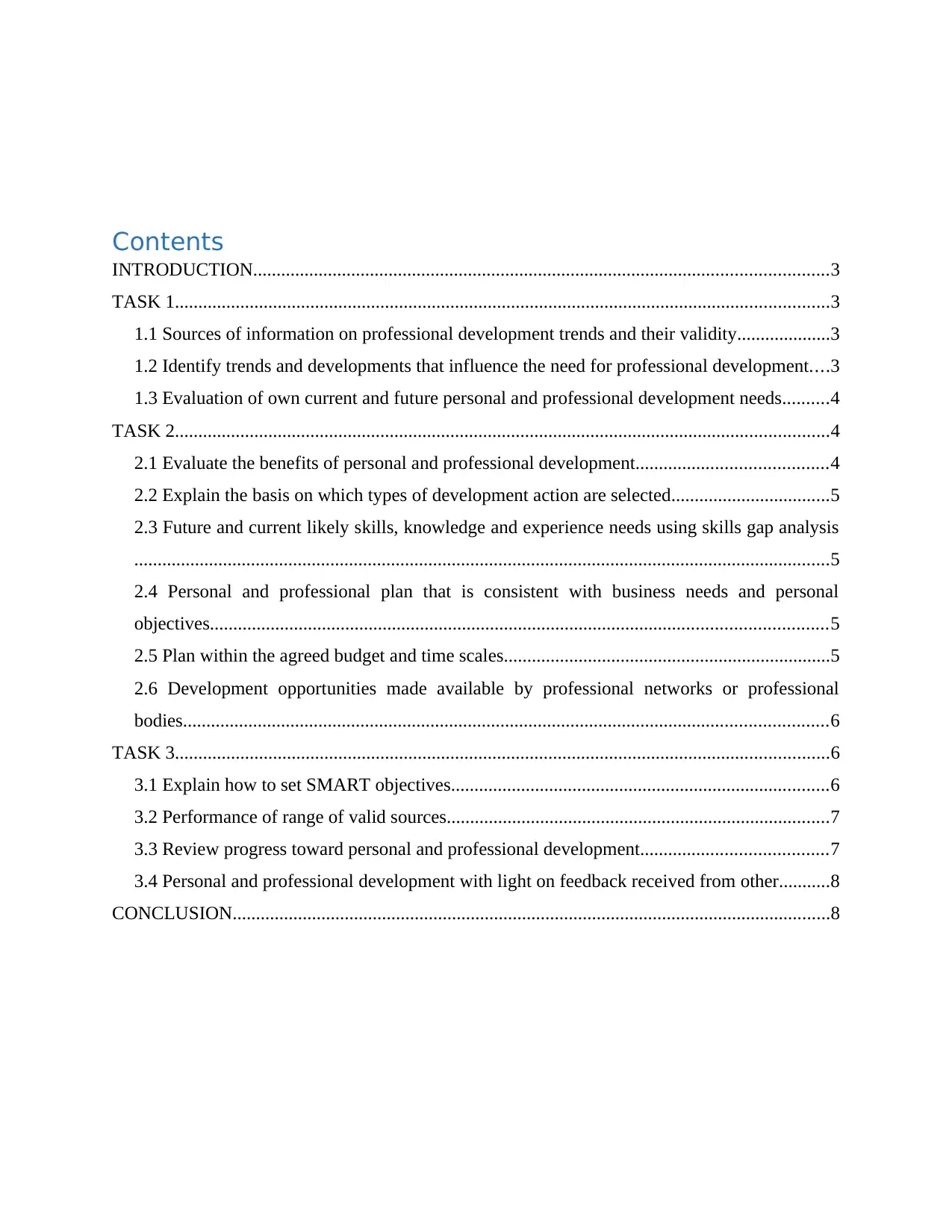
Contents
INTRODUCTION...........................................................................................................................3
TASK 1............................................................................................................................................3
1.1 Sources of information on professional development trends and their validity....................3
1.2 Identify trends and developments that influence the need for professional development....3
1.3 Evaluation of own current and future personal and professional development needs..........4
TASK 2............................................................................................................................................4
2.1 Evaluate the benefits of personal and professional development.........................................4
2.2 Explain the basis on which types of development action are selected..................................5
2.3 Future and current likely skills, knowledge and experience needs using skills gap analysis
.....................................................................................................................................................5
2.4 Personal and professional plan that is consistent with business needs and personal
objectives....................................................................................................................................5
2.5 Plan within the agreed budget and time scales......................................................................5
2.6 Development opportunities made available by professional networks or professional
bodies..........................................................................................................................................6
TASK 3............................................................................................................................................6
3.1 Explain how to set SMART objectives.................................................................................6
3.2 Performance of range of valid sources..................................................................................7
3.3 Review progress toward personal and professional development........................................7
3.4 Personal and professional development with light on feedback received from other...........8
CONCLUSION................................................................................................................................8
INTRODUCTION...........................................................................................................................3
TASK 1............................................................................................................................................3
1.1 Sources of information on professional development trends and their validity....................3
1.2 Identify trends and developments that influence the need for professional development....3
1.3 Evaluation of own current and future personal and professional development needs..........4
TASK 2............................................................................................................................................4
2.1 Evaluate the benefits of personal and professional development.........................................4
2.2 Explain the basis on which types of development action are selected..................................5
2.3 Future and current likely skills, knowledge and experience needs using skills gap analysis
.....................................................................................................................................................5
2.4 Personal and professional plan that is consistent with business needs and personal
objectives....................................................................................................................................5
2.5 Plan within the agreed budget and time scales......................................................................5
2.6 Development opportunities made available by professional networks or professional
bodies..........................................................................................................................................6
TASK 3............................................................................................................................................6
3.1 Explain how to set SMART objectives.................................................................................6
3.2 Performance of range of valid sources..................................................................................7
3.3 Review progress toward personal and professional development........................................7
3.4 Personal and professional development with light on feedback received from other...........8
CONCLUSION................................................................................................................................8
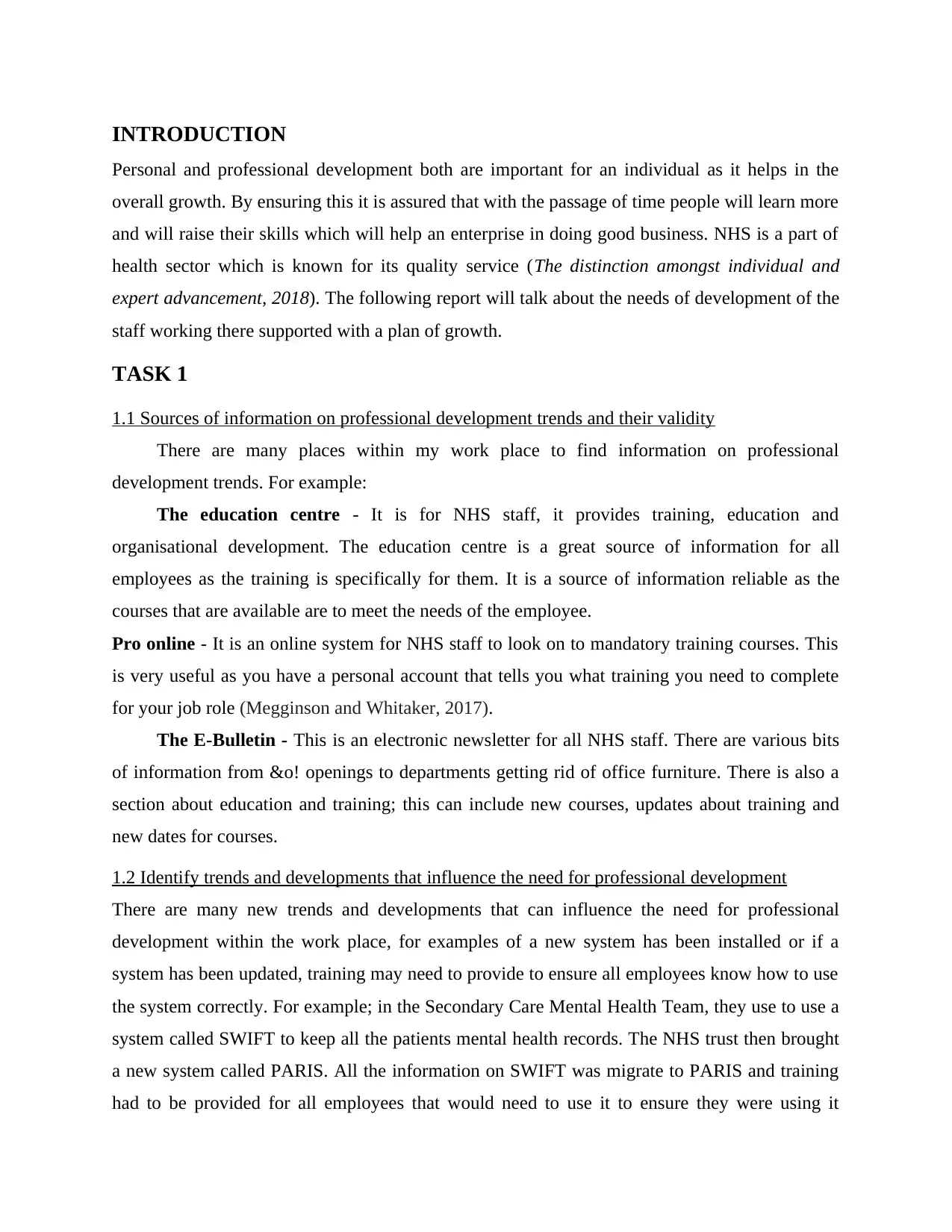
INTRODUCTION
Personal and professional development both are important for an individual as it helps in the
overall growth. By ensuring this it is assured that with the passage of time people will learn more
and will raise their skills which will help an enterprise in doing good business. NHS is a part of
health sector which is known for its quality service (The distinction amongst individual and
expert advancement, 2018). The following report will talk about the needs of development of the
staff working there supported with a plan of growth.
TASK 1
1.1 Sources of information on professional development trends and their validity
There are many places within my work place to find information on professional
development trends. For example:
The education centre - It is for NHS staff, it provides training, education and
organisational development. The education centre is a great source of information for all
employees as the training is specifically for them. It is a source of information reliable as the
courses that are available are to meet the needs of the employee.
Pro online - It is an online system for NHS staff to look on to mandatory training courses. This
is very useful as you have a personal account that tells you what training you need to complete
for your job role (Megginson and Whitaker, 2017).
The E-Bulletin - This is an electronic newsletter for all NHS staff. There are various bits
of information from &o! openings to departments getting rid of office furniture. There is also a
section about education and training; this can include new courses, updates about training and
new dates for courses.
1.2 Identify trends and developments that influence the need for professional development
There are many new trends and developments that can influence the need for professional
development within the work place, for examples of a new system has been installed or if a
system has been updated, training may need to provide to ensure all employees know how to use
the system correctly. For example; in the Secondary Care Mental Health Team, they use to use a
system called SWIFT to keep all the patients mental health records. The NHS trust then brought
a new system called PARIS. All the information on SWIFT was migrate to PARIS and training
had to be provided for all employees that would need to use it to ensure they were using it
Personal and professional development both are important for an individual as it helps in the
overall growth. By ensuring this it is assured that with the passage of time people will learn more
and will raise their skills which will help an enterprise in doing good business. NHS is a part of
health sector which is known for its quality service (The distinction amongst individual and
expert advancement, 2018). The following report will talk about the needs of development of the
staff working there supported with a plan of growth.
TASK 1
1.1 Sources of information on professional development trends and their validity
There are many places within my work place to find information on professional
development trends. For example:
The education centre - It is for NHS staff, it provides training, education and
organisational development. The education centre is a great source of information for all
employees as the training is specifically for them. It is a source of information reliable as the
courses that are available are to meet the needs of the employee.
Pro online - It is an online system for NHS staff to look on to mandatory training courses. This
is very useful as you have a personal account that tells you what training you need to complete
for your job role (Megginson and Whitaker, 2017).
The E-Bulletin - This is an electronic newsletter for all NHS staff. There are various bits
of information from &o! openings to departments getting rid of office furniture. There is also a
section about education and training; this can include new courses, updates about training and
new dates for courses.
1.2 Identify trends and developments that influence the need for professional development
There are many new trends and developments that can influence the need for professional
development within the work place, for examples of a new system has been installed or if a
system has been updated, training may need to provide to ensure all employees know how to use
the system correctly. For example; in the Secondary Care Mental Health Team, they use to use a
system called SWIFT to keep all the patients mental health records. The NHS trust then brought
a new system called PARIS. All the information on SWIFT was migrate to PARIS and training
had to be provided for all employees that would need to use it to ensure they were using it
⊘ This is a preview!⊘
Do you want full access?
Subscribe today to unlock all pages.

Trusted by 1+ million students worldwide
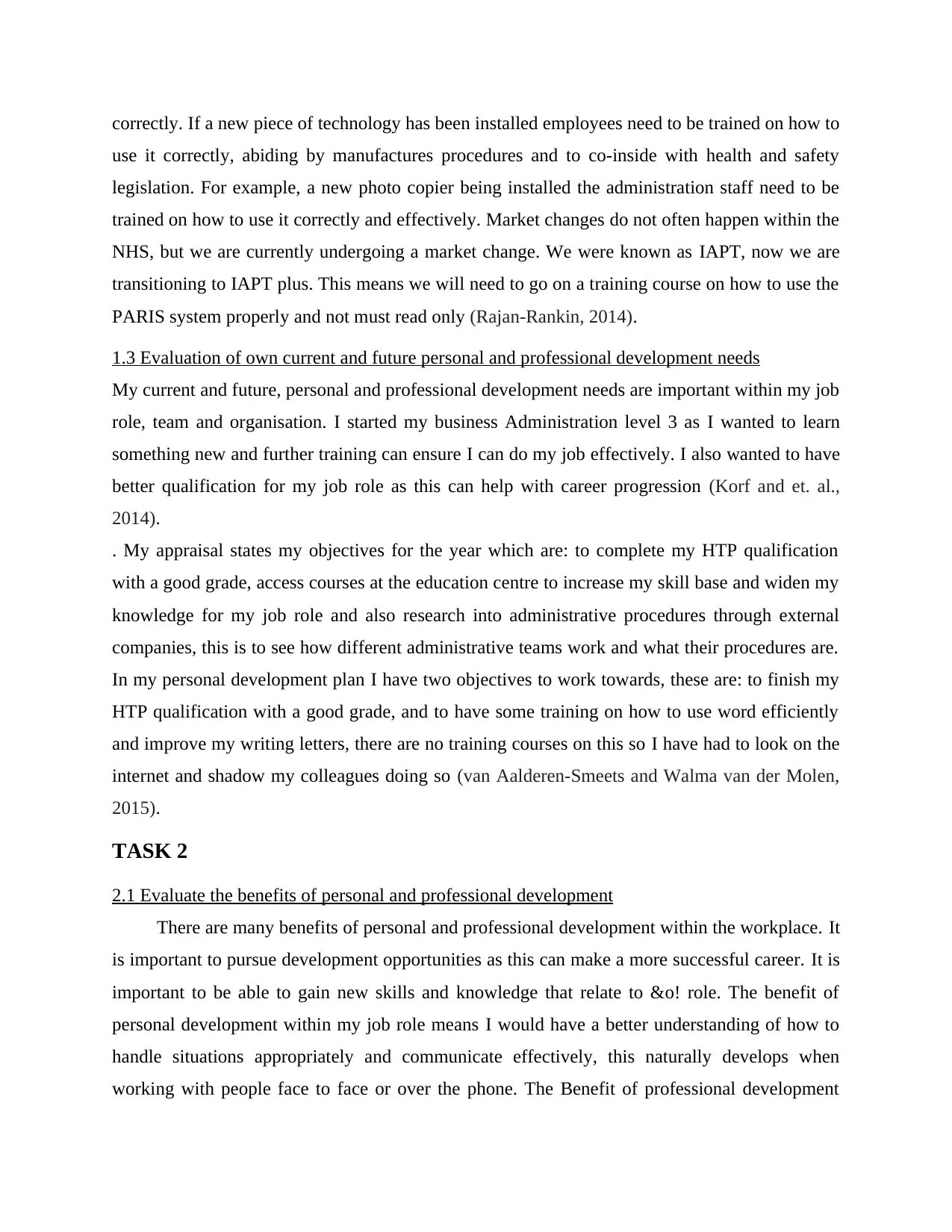
correctly. If a new piece of technology has been installed employees need to be trained on how to
use it correctly, abiding by manufactures procedures and to co-inside with health and safety
legislation. For example, a new photo copier being installed the administration staff need to be
trained on how to use it correctly and effectively. Market changes do not often happen within the
NHS, but we are currently undergoing a market change. We were known as IAPT, now we are
transitioning to IAPT plus. This means we will need to go on a training course on how to use the
PARIS system properly and not must read only (Rajan-Rankin, 2014).
1.3 Evaluation of own current and future personal and professional development needs
My current and future, personal and professional development needs are important within my job
role, team and organisation. I started my business Administration level 3 as I wanted to learn
something new and further training can ensure I can do my job effectively. I also wanted to have
better qualification for my job role as this can help with career progression (Korf and et. al.,
2014).
. My appraisal states my objectives for the year which are: to complete my HTP qualification
with a good grade, access courses at the education centre to increase my skill base and widen my
knowledge for my job role and also research into administrative procedures through external
companies, this is to see how different administrative teams work and what their procedures are.
In my personal development plan I have two objectives to work towards, these are: to finish my
HTP qualification with a good grade, and to have some training on how to use word efficiently
and improve my writing letters, there are no training courses on this so I have had to look on the
internet and shadow my colleagues doing so (van Aalderen‐Smeets and Walma van der Molen,
2015).
TASK 2
2.1 Evaluate the benefits of personal and professional development
There are many benefits of personal and professional development within the workplace. It
is important to pursue development opportunities as this can make a more successful career. It is
important to be able to gain new skills and knowledge that relate to &o! role. The benefit of
personal development within my job role means I would have a better understanding of how to
handle situations appropriately and communicate effectively, this naturally develops when
working with people face to face or over the phone. The Benefit of professional development
use it correctly, abiding by manufactures procedures and to co-inside with health and safety
legislation. For example, a new photo copier being installed the administration staff need to be
trained on how to use it correctly and effectively. Market changes do not often happen within the
NHS, but we are currently undergoing a market change. We were known as IAPT, now we are
transitioning to IAPT plus. This means we will need to go on a training course on how to use the
PARIS system properly and not must read only (Rajan-Rankin, 2014).
1.3 Evaluation of own current and future personal and professional development needs
My current and future, personal and professional development needs are important within my job
role, team and organisation. I started my business Administration level 3 as I wanted to learn
something new and further training can ensure I can do my job effectively. I also wanted to have
better qualification for my job role as this can help with career progression (Korf and et. al.,
2014).
. My appraisal states my objectives for the year which are: to complete my HTP qualification
with a good grade, access courses at the education centre to increase my skill base and widen my
knowledge for my job role and also research into administrative procedures through external
companies, this is to see how different administrative teams work and what their procedures are.
In my personal development plan I have two objectives to work towards, these are: to finish my
HTP qualification with a good grade, and to have some training on how to use word efficiently
and improve my writing letters, there are no training courses on this so I have had to look on the
internet and shadow my colleagues doing so (van Aalderen‐Smeets and Walma van der Molen,
2015).
TASK 2
2.1 Evaluate the benefits of personal and professional development
There are many benefits of personal and professional development within the workplace. It
is important to pursue development opportunities as this can make a more successful career. It is
important to be able to gain new skills and knowledge that relate to &o! role. The benefit of
personal development within my job role means I would have a better understanding of how to
handle situations appropriately and communicate effectively, this naturally develops when
working with people face to face or over the phone. The Benefit of professional development
Paraphrase This Document
Need a fresh take? Get an instant paraphrase of this document with our AI Paraphraser
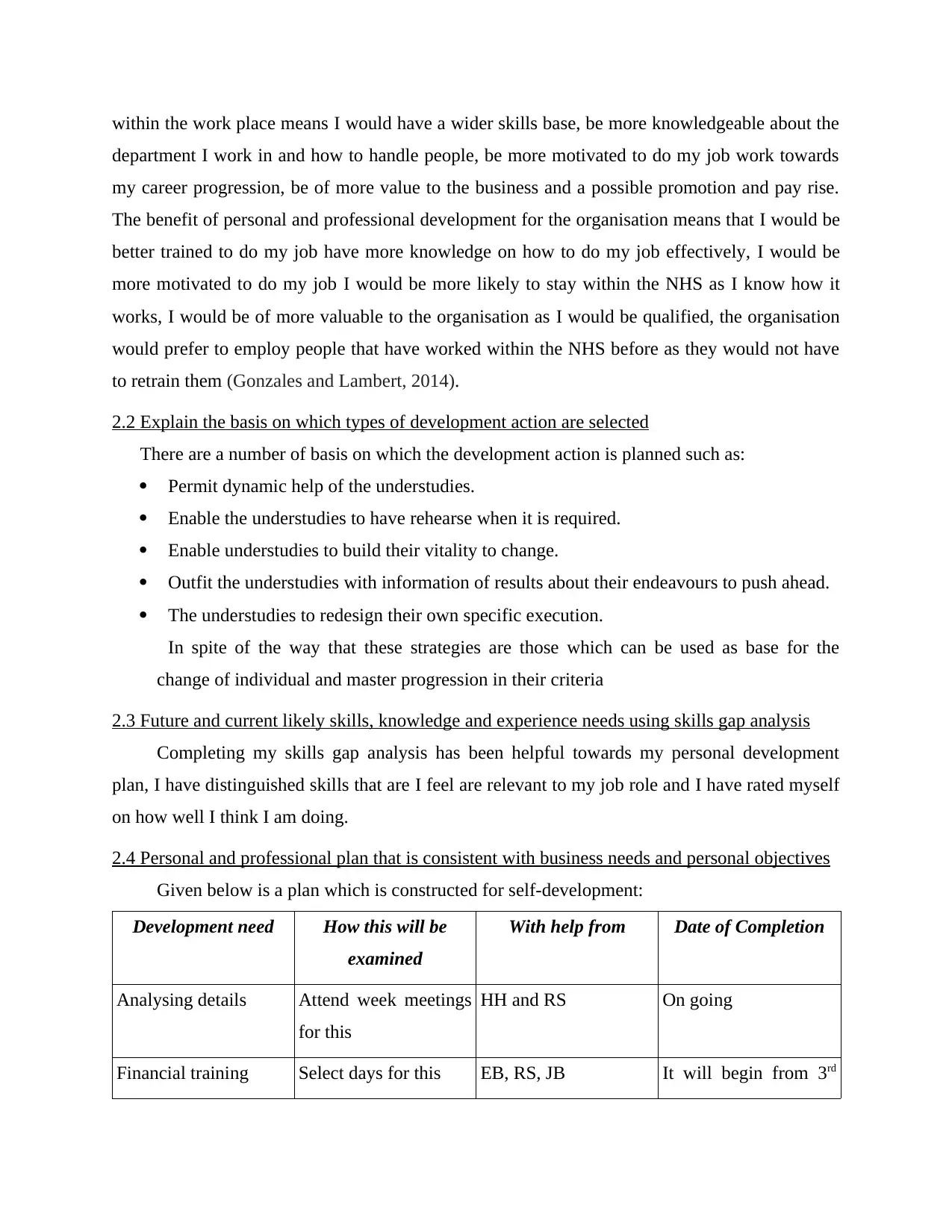
within the work place means I would have a wider skills base, be more knowledgeable about the
department I work in and how to handle people, be more motivated to do my job work towards
my career progression, be of more value to the business and a possible promotion and pay rise.
The benefit of personal and professional development for the organisation means that I would be
better trained to do my job have more knowledge on how to do my job effectively, I would be
more motivated to do my job I would be more likely to stay within the NHS as I know how it
works, I would be of more valuable to the organisation as I would be qualified, the organisation
would prefer to employ people that have worked within the NHS before as they would not have
to retrain them (Gonzales and Lambert, 2014).
2.2 Explain the basis on which types of development action are selected
There are a number of basis on which the development action is planned such as:
Permit dynamic help of the understudies.
Enable the understudies to have rehearse when it is required.
Enable understudies to build their vitality to change.
Outfit the understudies with information of results about their endeavours to push ahead.
The understudies to redesign their own specific execution.
In spite of the way that these strategies are those which can be used as base for the
change of individual and master progression in their criteria
2.3 Future and current likely skills, knowledge and experience needs using skills gap analysis
Completing my skills gap analysis has been helpful towards my personal development
plan, I have distinguished skills that are I feel are relevant to my job role and I have rated myself
on how well I think I am doing.
2.4 Personal and professional plan that is consistent with business needs and personal objectives
Given below is a plan which is constructed for self-development:
Development need How this will be
examined
With help from Date of Completion
Analysing details Attend week meetings
for this
HH and RS On going
Financial training Select days for this EB, RS, JB It will begin from 3rd
department I work in and how to handle people, be more motivated to do my job work towards
my career progression, be of more value to the business and a possible promotion and pay rise.
The benefit of personal and professional development for the organisation means that I would be
better trained to do my job have more knowledge on how to do my job effectively, I would be
more motivated to do my job I would be more likely to stay within the NHS as I know how it
works, I would be of more valuable to the organisation as I would be qualified, the organisation
would prefer to employ people that have worked within the NHS before as they would not have
to retrain them (Gonzales and Lambert, 2014).
2.2 Explain the basis on which types of development action are selected
There are a number of basis on which the development action is planned such as:
Permit dynamic help of the understudies.
Enable the understudies to have rehearse when it is required.
Enable understudies to build their vitality to change.
Outfit the understudies with information of results about their endeavours to push ahead.
The understudies to redesign their own specific execution.
In spite of the way that these strategies are those which can be used as base for the
change of individual and master progression in their criteria
2.3 Future and current likely skills, knowledge and experience needs using skills gap analysis
Completing my skills gap analysis has been helpful towards my personal development
plan, I have distinguished skills that are I feel are relevant to my job role and I have rated myself
on how well I think I am doing.
2.4 Personal and professional plan that is consistent with business needs and personal objectives
Given below is a plan which is constructed for self-development:
Development need How this will be
examined
With help from Date of Completion
Analysing details Attend week meetings
for this
HH and RS On going
Financial training Select days for this EB, RS, JB It will begin from 3rd
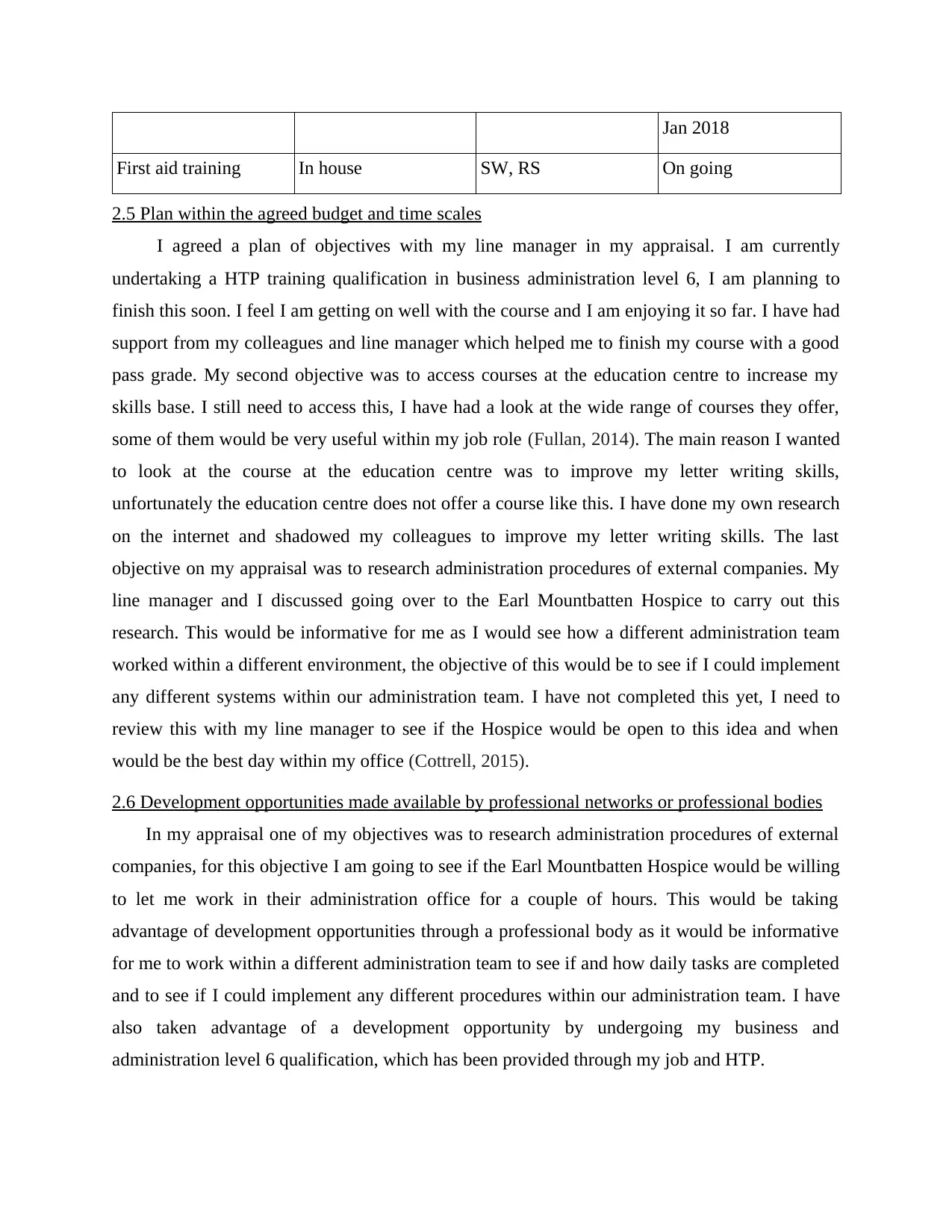
Jan 2018
First aid training In house SW, RS On going
2.5 Plan within the agreed budget and time scales
I agreed a plan of objectives with my line manager in my appraisal. I am currently
undertaking a HTP training qualification in business administration level 6, I am planning to
finish this soon. I feel I am getting on well with the course and I am enjoying it so far. I have had
support from my colleagues and line manager which helped me to finish my course with a good
pass grade. My second objective was to access courses at the education centre to increase my
skills base. I still need to access this, I have had a look at the wide range of courses they offer,
some of them would be very useful within my job role (Fullan, 2014). The main reason I wanted
to look at the course at the education centre was to improve my letter writing skills,
unfortunately the education centre does not offer a course like this. I have done my own research
on the internet and shadowed my colleagues to improve my letter writing skills. The last
objective on my appraisal was to research administration procedures of external companies. My
line manager and I discussed going over to the Earl Mountbatten Hospice to carry out this
research. This would be informative for me as I would see how a different administration team
worked within a different environment, the objective of this would be to see if I could implement
any different systems within our administration team. I have not completed this yet, I need to
review this with my line manager to see if the Hospice would be open to this idea and when
would be the best day within my office (Cottrell, 2015).
2.6 Development opportunities made available by professional networks or professional bodies
In my appraisal one of my objectives was to research administration procedures of external
companies, for this objective I am going to see if the Earl Mountbatten Hospice would be willing
to let me work in their administration office for a couple of hours. This would be taking
advantage of development opportunities through a professional body as it would be informative
for me to work within a different administration team to see if and how daily tasks are completed
and to see if I could implement any different procedures within our administration team. I have
also taken advantage of a development opportunity by undergoing my business and
administration level 6 qualification, which has been provided through my job and HTP.
First aid training In house SW, RS On going
2.5 Plan within the agreed budget and time scales
I agreed a plan of objectives with my line manager in my appraisal. I am currently
undertaking a HTP training qualification in business administration level 6, I am planning to
finish this soon. I feel I am getting on well with the course and I am enjoying it so far. I have had
support from my colleagues and line manager which helped me to finish my course with a good
pass grade. My second objective was to access courses at the education centre to increase my
skills base. I still need to access this, I have had a look at the wide range of courses they offer,
some of them would be very useful within my job role (Fullan, 2014). The main reason I wanted
to look at the course at the education centre was to improve my letter writing skills,
unfortunately the education centre does not offer a course like this. I have done my own research
on the internet and shadowed my colleagues to improve my letter writing skills. The last
objective on my appraisal was to research administration procedures of external companies. My
line manager and I discussed going over to the Earl Mountbatten Hospice to carry out this
research. This would be informative for me as I would see how a different administration team
worked within a different environment, the objective of this would be to see if I could implement
any different systems within our administration team. I have not completed this yet, I need to
review this with my line manager to see if the Hospice would be open to this idea and when
would be the best day within my office (Cottrell, 2015).
2.6 Development opportunities made available by professional networks or professional bodies
In my appraisal one of my objectives was to research administration procedures of external
companies, for this objective I am going to see if the Earl Mountbatten Hospice would be willing
to let me work in their administration office for a couple of hours. This would be taking
advantage of development opportunities through a professional body as it would be informative
for me to work within a different administration team to see if and how daily tasks are completed
and to see if I could implement any different procedures within our administration team. I have
also taken advantage of a development opportunity by undergoing my business and
administration level 6 qualification, which has been provided through my job and HTP.
⊘ This is a preview!⊘
Do you want full access?
Subscribe today to unlock all pages.

Trusted by 1+ million students worldwide
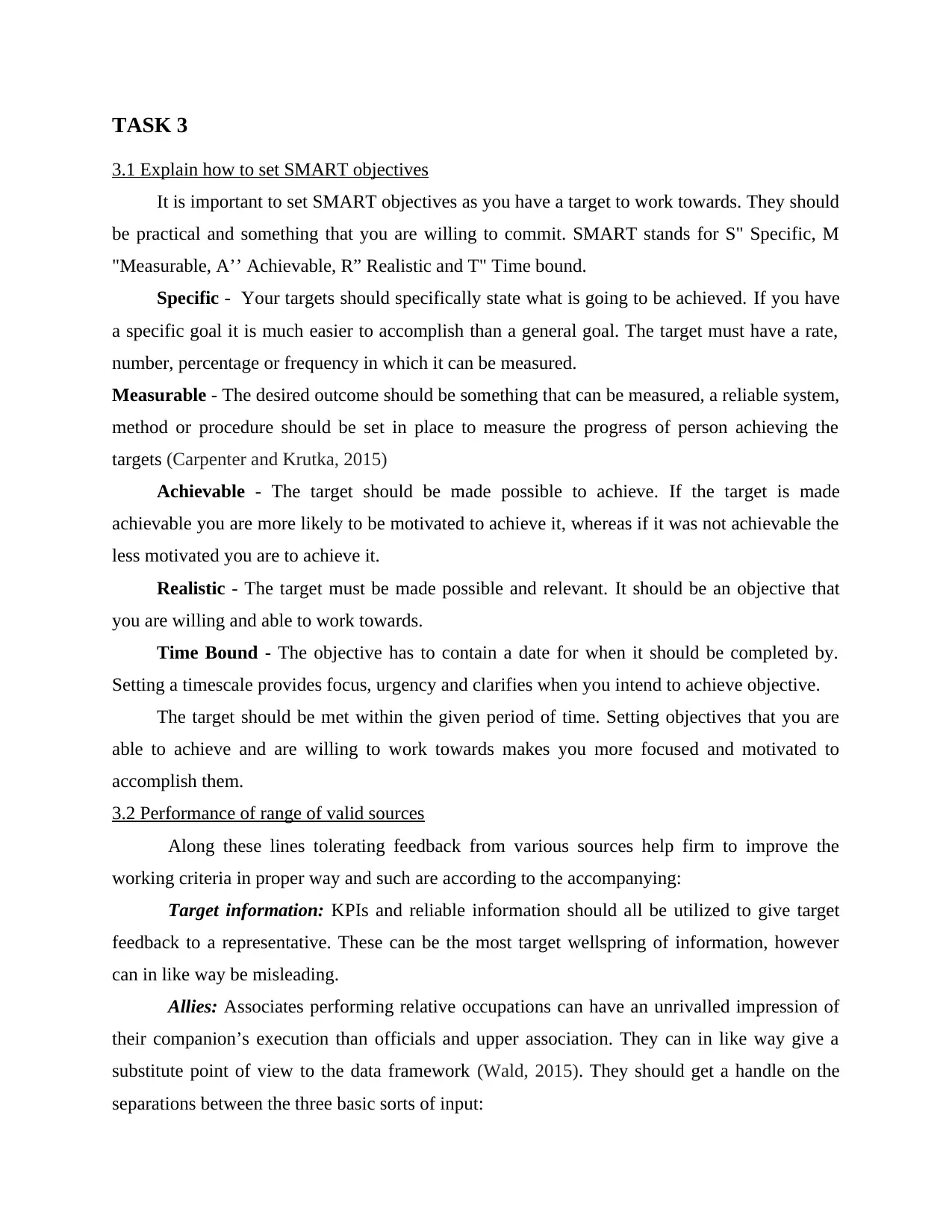
TASK 3
3.1 Explain how to set SMART objectives
It is important to set SMART objectives as you have a target to work towards. They should
be practical and something that you are willing to commit. SMART stands for S" Specific, M
"Measurable, A’’ Achievable, R” Realistic and T" Time bound.
Specific - Your targets should specifically state what is going to be achieved. If you have
a specific goal it is much easier to accomplish than a general goal. The target must have a rate,
number, percentage or frequency in which it can be measured.
Measurable - The desired outcome should be something that can be measured, a reliable system,
method or procedure should be set in place to measure the progress of person achieving the
targets (Carpenter and Krutka, 2015)
Achievable - The target should be made possible to achieve. If the target is made
achievable you are more likely to be motivated to achieve it, whereas if it was not achievable the
less motivated you are to achieve it.
Realistic - The target must be made possible and relevant. It should be an objective that
you are willing and able to work towards.
Time Bound - The objective has to contain a date for when it should be completed by.
Setting a timescale provides focus, urgency and clarifies when you intend to achieve objective.
The target should be met within the given period of time. Setting objectives that you are
able to achieve and are willing to work towards makes you more focused and motivated to
accomplish them.
3.2 Performance of range of valid sources
Along these lines tolerating feedback from various sources help firm to improve the
working criteria in proper way and such are according to the accompanying:
Target information: KPIs and reliable information should all be utilized to give target
feedback to a representative. These can be the most target wellspring of information, however
can in like way be misleading.
Allies: Associates performing relative occupations can have an unrivalled impression of
their companion’s execution than officials and upper association. They can in like way give a
substitute point of view to the data framework (Wald, 2015). They should get a handle on the
separations between the three basic sorts of input:
3.1 Explain how to set SMART objectives
It is important to set SMART objectives as you have a target to work towards. They should
be practical and something that you are willing to commit. SMART stands for S" Specific, M
"Measurable, A’’ Achievable, R” Realistic and T" Time bound.
Specific - Your targets should specifically state what is going to be achieved. If you have
a specific goal it is much easier to accomplish than a general goal. The target must have a rate,
number, percentage or frequency in which it can be measured.
Measurable - The desired outcome should be something that can be measured, a reliable system,
method or procedure should be set in place to measure the progress of person achieving the
targets (Carpenter and Krutka, 2015)
Achievable - The target should be made possible to achieve. If the target is made
achievable you are more likely to be motivated to achieve it, whereas if it was not achievable the
less motivated you are to achieve it.
Realistic - The target must be made possible and relevant. It should be an objective that
you are willing and able to work towards.
Time Bound - The objective has to contain a date for when it should be completed by.
Setting a timescale provides focus, urgency and clarifies when you intend to achieve objective.
The target should be met within the given period of time. Setting objectives that you are
able to achieve and are willing to work towards makes you more focused and motivated to
accomplish them.
3.2 Performance of range of valid sources
Along these lines tolerating feedback from various sources help firm to improve the
working criteria in proper way and such are according to the accompanying:
Target information: KPIs and reliable information should all be utilized to give target
feedback to a representative. These can be the most target wellspring of information, however
can in like way be misleading.
Allies: Associates performing relative occupations can have an unrivalled impression of
their companion’s execution than officials and upper association. They can in like way give a
substitute point of view to the data framework (Wald, 2015). They should get a handle on the
separations between the three basic sorts of input:
Paraphrase This Document
Need a fresh take? Get an instant paraphrase of this document with our AI Paraphraser
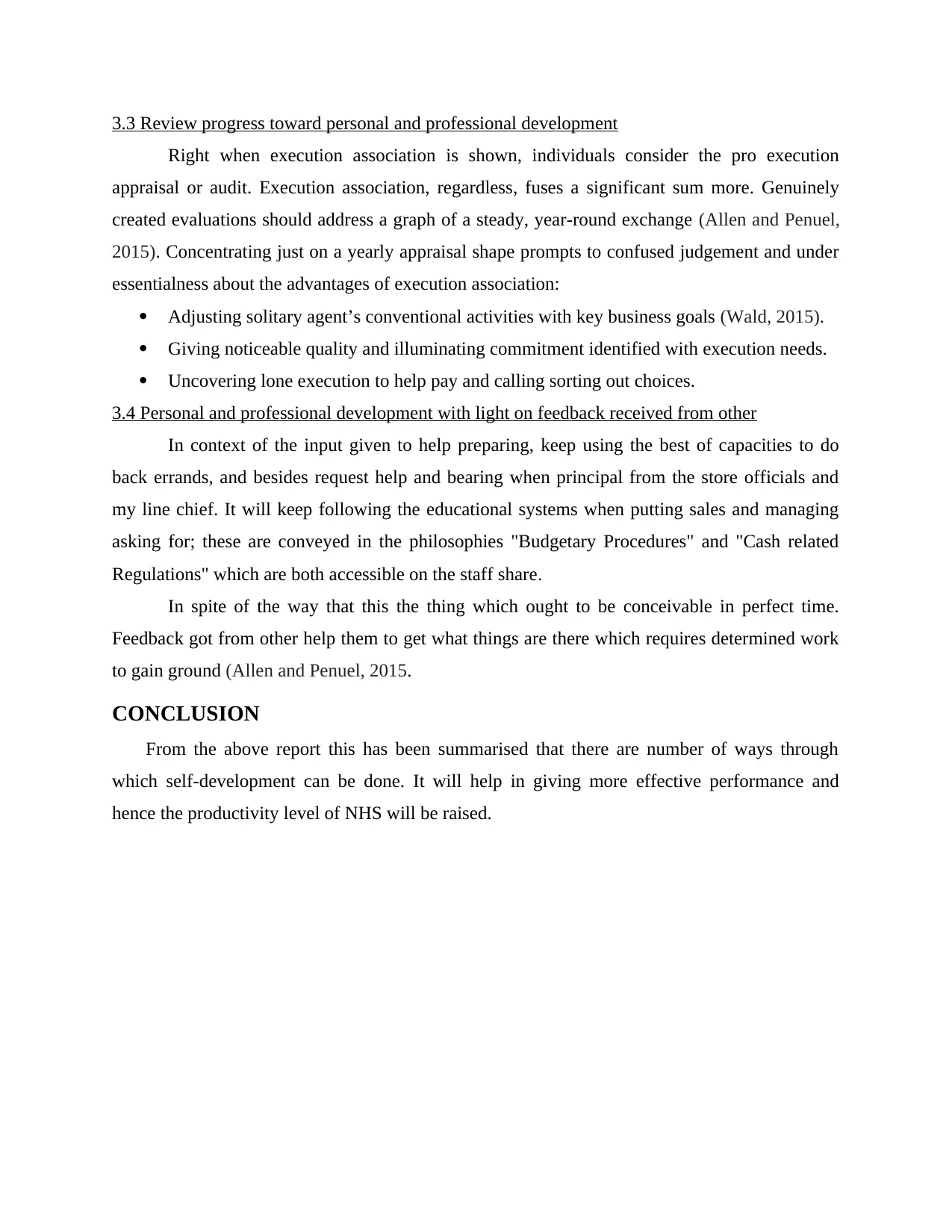
3.3 Review progress toward personal and professional development
Right when execution association is shown, individuals consider the pro execution
appraisal or audit. Execution association, regardless, fuses a significant sum more. Genuinely
created evaluations should address a graph of a steady, year-round exchange (Allen and Penuel,
2015). Concentrating just on a yearly appraisal shape prompts to confused judgement and under
essentialness about the advantages of execution association:
Adjusting solitary agent’s conventional activities with key business goals (Wald, 2015).
Giving noticeable quality and illuminating commitment identified with execution needs.
Uncovering lone execution to help pay and calling sorting out choices.
3.4 Personal and professional development with light on feedback received from other
In context of the input given to help preparing, keep using the best of capacities to do
back errands, and besides request help and bearing when principal from the store officials and
my line chief. It will keep following the educational systems when putting sales and managing
asking for; these are conveyed in the philosophies "Budgetary Procedures" and "Cash related
Regulations" which are both accessible on the staff share.
In spite of the way that this the thing which ought to be conceivable in perfect time.
Feedback got from other help them to get what things are there which requires determined work
to gain ground (Allen and Penuel, 2015.
CONCLUSION
From the above report this has been summarised that there are number of ways through
which self-development can be done. It will help in giving more effective performance and
hence the productivity level of NHS will be raised.
Right when execution association is shown, individuals consider the pro execution
appraisal or audit. Execution association, regardless, fuses a significant sum more. Genuinely
created evaluations should address a graph of a steady, year-round exchange (Allen and Penuel,
2015). Concentrating just on a yearly appraisal shape prompts to confused judgement and under
essentialness about the advantages of execution association:
Adjusting solitary agent’s conventional activities with key business goals (Wald, 2015).
Giving noticeable quality and illuminating commitment identified with execution needs.
Uncovering lone execution to help pay and calling sorting out choices.
3.4 Personal and professional development with light on feedback received from other
In context of the input given to help preparing, keep using the best of capacities to do
back errands, and besides request help and bearing when principal from the store officials and
my line chief. It will keep following the educational systems when putting sales and managing
asking for; these are conveyed in the philosophies "Budgetary Procedures" and "Cash related
Regulations" which are both accessible on the staff share.
In spite of the way that this the thing which ought to be conceivable in perfect time.
Feedback got from other help them to get what things are there which requires determined work
to gain ground (Allen and Penuel, 2015.
CONCLUSION
From the above report this has been summarised that there are number of ways through
which self-development can be done. It will help in giving more effective performance and
hence the productivity level of NHS will be raised.
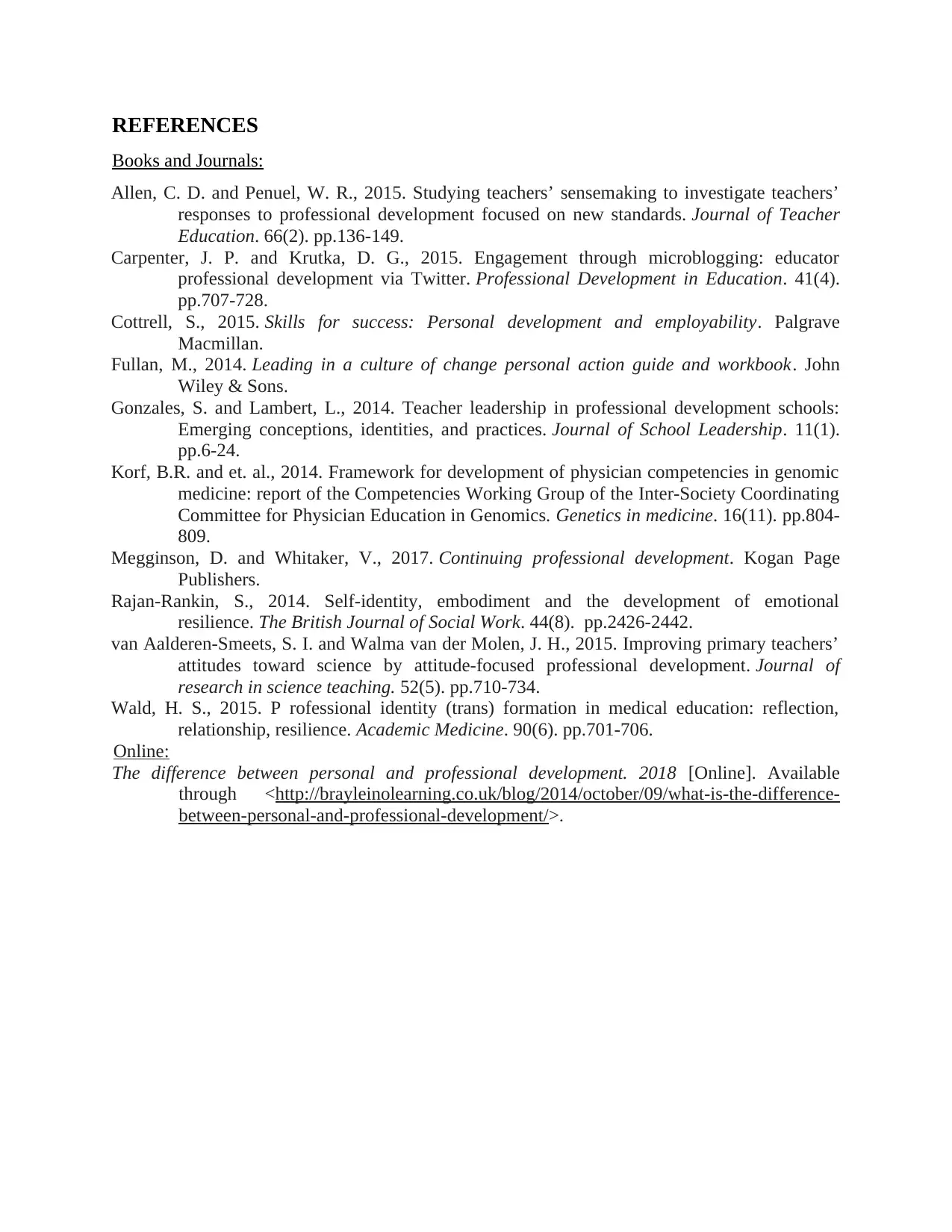
REFERENCES
Books and Journals:
Allen, C. D. and Penuel, W. R., 2015. Studying teachers’ sensemaking to investigate teachers’
responses to professional development focused on new standards. Journal of Teacher
Education. 66(2). pp.136-149.
Carpenter, J. P. and Krutka, D. G., 2015. Engagement through microblogging: educator
professional development via Twitter. Professional Development in Education. 41(4).
pp.707-728.
Cottrell, S., 2015. Skills for success: Personal development and employability. Palgrave
Macmillan.
Fullan, M., 2014. Leading in a culture of change personal action guide and workbook. John
Wiley & Sons.
Gonzales, S. and Lambert, L., 2014. Teacher leadership in professional development schools:
Emerging conceptions, identities, and practices. Journal of School Leadership. 11(1).
pp.6-24.
Korf, B.R. and et. al., 2014. Framework for development of physician competencies in genomic
medicine: report of the Competencies Working Group of the Inter-Society Coordinating
Committee for Physician Education in Genomics. Genetics in medicine. 16(11). pp.804-
809.
Megginson, D. and Whitaker, V., 2017. Continuing professional development. Kogan Page
Publishers.
Rajan-Rankin, S., 2014. Self-identity, embodiment and the development of emotional
resilience. The British Journal of Social Work. 44(8). pp.2426-2442.
van Aalderen‐Smeets, S. I. and Walma van der Molen, J. H., 2015. Improving primary teachers’
attitudes toward science by attitude‐focused professional development. Journal of
research in science teaching. 52(5). pp.710-734.
Wald, H. S., 2015. P rofessional identity (trans) formation in medical education: reflection,
relationship, resilience. Academic Medicine. 90(6). pp.701-706.
Online:
The difference between personal and professional development. 2018 [Online]. Available
through <http://brayleinolearning.co.uk/blog/2014/october/09/what-is-the-difference-
between-personal-and-professional-development/>.
Books and Journals:
Allen, C. D. and Penuel, W. R., 2015. Studying teachers’ sensemaking to investigate teachers’
responses to professional development focused on new standards. Journal of Teacher
Education. 66(2). pp.136-149.
Carpenter, J. P. and Krutka, D. G., 2015. Engagement through microblogging: educator
professional development via Twitter. Professional Development in Education. 41(4).
pp.707-728.
Cottrell, S., 2015. Skills for success: Personal development and employability. Palgrave
Macmillan.
Fullan, M., 2014. Leading in a culture of change personal action guide and workbook. John
Wiley & Sons.
Gonzales, S. and Lambert, L., 2014. Teacher leadership in professional development schools:
Emerging conceptions, identities, and practices. Journal of School Leadership. 11(1).
pp.6-24.
Korf, B.R. and et. al., 2014. Framework for development of physician competencies in genomic
medicine: report of the Competencies Working Group of the Inter-Society Coordinating
Committee for Physician Education in Genomics. Genetics in medicine. 16(11). pp.804-
809.
Megginson, D. and Whitaker, V., 2017. Continuing professional development. Kogan Page
Publishers.
Rajan-Rankin, S., 2014. Self-identity, embodiment and the development of emotional
resilience. The British Journal of Social Work. 44(8). pp.2426-2442.
van Aalderen‐Smeets, S. I. and Walma van der Molen, J. H., 2015. Improving primary teachers’
attitudes toward science by attitude‐focused professional development. Journal of
research in science teaching. 52(5). pp.710-734.
Wald, H. S., 2015. P rofessional identity (trans) formation in medical education: reflection,
relationship, resilience. Academic Medicine. 90(6). pp.701-706.
Online:
The difference between personal and professional development. 2018 [Online]. Available
through <http://brayleinolearning.co.uk/blog/2014/october/09/what-is-the-difference-
between-personal-and-professional-development/>.
⊘ This is a preview!⊘
Do you want full access?
Subscribe today to unlock all pages.

Trusted by 1+ million students worldwide

Paraphrase This Document
Need a fresh take? Get an instant paraphrase of this document with our AI Paraphraser

1
1 out of 11
Related Documents
Your All-in-One AI-Powered Toolkit for Academic Success.
+13062052269
info@desklib.com
Available 24*7 on WhatsApp / Email
![[object Object]](/_next/static/media/star-bottom.7253800d.svg)
Unlock your academic potential
Copyright © 2020–2025 A2Z Services. All Rights Reserved. Developed and managed by ZUCOL.





